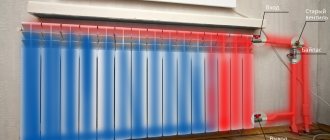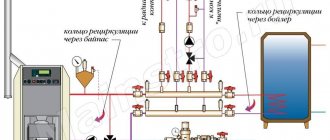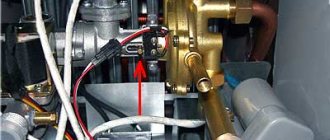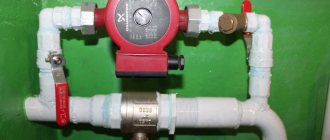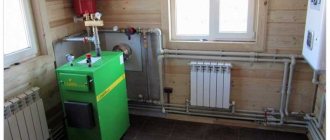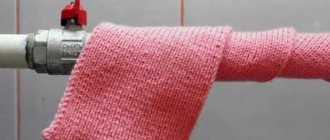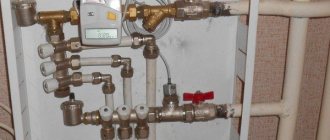Have you already experienced the harmful effects of limescale?
Washing machine, coffee machine, gas boiler... Which of them became the latest victim of limescale?
Do you want to know more - what is scale and how to deal with it?
Read our article! We have been dealing with the issue of protecting equipment from scale for a long time and are confident that our knowledge will be useful to you!
In the photo: samples of scale from pipes taken by us for research
Why is scale dangerous?
Scale has extremely low thermal conductivity.
For example: the thermal conductivity of steel is 39 kcal/m*hour*deg, and the thermal conductivity of scale is only 0.1 kcal/m*hour*deg. The difference is almost 400 times!
This means that when a boiler, kettle or heating element is operating, they have to spend more gas or electricity to heat and evaporate the liquid.
And that's not so bad.
Scale deposits damage equipment and devices, making their operation impossible!
Lime deposited on the surfaces of washing machines leads to burnout of the heating element. Scale deposited in the nozzles of coffee machines makes it impossible to supply liquid. Scale that clogs the coil of a gas boiler leads to its leakage and expensive repairs.
Deposits that arise during the operation of industrial boilers can lead to rupture of pipes and an emergency!
Due to our line of work, we come across various boilers every day and sometimes we are surprised at how careless people who operate high-power gas boilers are...
In the picture you can see that the boiler pipe is completely clogged with scale. Water does not pass through it, the pipe is constantly overheated and this can lead to an explosion! However, such a boiler continued to work...
In the photo: scale in the pipe of the boiler DE-10-14
Thus, the occurrence of scale in heating equipment leads to the following negative consequences:
- Excessive consumption of fuel and electricity;
- Accelerated wear and tear of equipment;
- Impossibility of implementing the technological process;
- The likelihood of an emergency;
Types of scale
The number of chemical elements from which scale is formed is quite diverse and, at a minimum, it is classified into the following types:
- carbonate scale (carbon dioxide salts of calcium and magnesium - CaCO3, MgCO3);
- sulphate scale (CaSO4);
- silicate scale (silicic acid compounds of calcium, magnesium, iron, aluminum).
Over 15 years of operation, our company has accumulated a significant number of scale samples from different parts of Russia. We examined more than 1000 scale samples and determined their chemical composition.
Pictured: the original scale sample and its crushed form for research
Based on the results of the study, we found that the scale content in the vast majority of samples contains the following elements:
Ca/Mg - from 87 to 96%
Fe - from 0.06 to 7.5%
SiO2 - from 0.02 to 1.8%
Is it possible to determine its chemical composition by the appearance of scale?
Based on our studies of more than 100 scale samples, we determined that:
It is not possible to unambiguously determine the chemical composition of scale by its appearance!
Too many factors affect the color and consistency of scale - the initial composition of the water, temperature, pressure at which scale forms. In addition, scale contains many more elements, which are very small in quantity, but they affect the color and character of the deposits.
For example:
Pictured: scale samples of different colors and consistencies
These images show sediments that differ significantly in color and physical structure. Surprisingly, these deposits have almost the same chemical composition! However, the different temperatures and pressures at which these scale samples formed resulted in such differences in color and texture!
At what temperature does scale form?
Scale begins to form at temperatures of 40°C and above.
We found fairly detailed information about the temperature and rate of scale formation in hot water preparation devices in the book by Vladislav Shaflik “Modern hot water supply systems”, Kyiv, “Taki Spravy”, 2010.
The table shows data on the dependence of the rate of scale formation on water hardness and temperature.
In the figure: data on the rate of scale formation depending on temperature
How to detect?
The presence of scale during heating with a heating boiler unit can be visualized by dismantling and partially disassembling it. However, in this case the warranty and service are lost. In addition, it is necessary to involve specialists to prevent damage to the structure.
Another detection method can be called indirect, since it can be implemented without disassembling the boiler itself. To do this, you need to turn off the boiler, wait until it cools down, and then unscrew the nut on the heating circuit pipe, drain the water and examine the condition of the inner surface. If scale is present, white deposits or salt flakes will be visible.
Preventing scale formation
Softening
The main way to prevent scale formation is softening.
The term “softening” refers to the process of purifying water from hardness salts (Ca and Mg), which are the main cause of scale formation.
The softening process removes calcium (Ca) and magnesium (Mg) ions from water. This is done by passing water through resin or salt containing sodium ions. In this case, calcium and magnesium ions from water pass into resin or salt, and sodium ions replace them and pass into water. This softens the water and reduces its overall hardness.
There are the following requirements for water hardness:
Feedwater of steam boilers and boilers (GOST R 55682.12-2013), mmol/l <0.02
There are a variety of softening installations that can be designed and selected according to the initial hardness of the water; in addition, there can be several stages of softening.
There are also reverse osmosis units that can produce almost distilled water at the output.
Anti-scale devices
Separately, it is necessary to say about various anti-scale devices, positioned as a means to prevent scale formation. Our organization has accumulated significant experience in operating various anti-scale devices. In addition, we ourselves produce an anti-scale device ECOFOR, designed to prevent the formation of scale and corrosion on steam and hot water boilers.
Pictured: explosion-proof version of the ECOFOR anti-scale device
We will soon post on our website a summary of our experience in operating anti-scale devices. Now let us note that, unfortunately, they are not a panacea and a reason for abandoning existing water treatment systems. These devices should be used as an addition to existing softening systems. The effectiveness of these devices depends on a huge number of factors: dimensions, coolant parameters, chemical composition of water, etc.
Reasons for failure of capacitive water heaters
The main reasons that shorten the life of a cylinder water heater and lead to failure are corrosion, as well as scale, which reduces the efficiency of the device.
Before considering these reasons in detail, it is necessary to dwell on some properties of water.
Water is not only a component of all living organisms and all living things, it is both an electrolyte (electrically conductive solution) and a universal solvent.
In the presence of even a small electric field in the water of a capacitive heater, galvanic currents will certainly flow. Water, as a universal solvent, dissolves even what such an aggressive environment as acid cannot dissolve. And if at least two different metals are present in the heater container, then both metals will transfer their ions to the electrolyte, that is, water.
If the electromagnetic field were constant and the electrolyte solution was not replenished, then the moment of equilibrium would come - the electrolyte solution would become saturated and all the ions would move into the solution and onto the oppositely charged electrodes. But since the water in tank water heaters is renewed, corrosion due to the constant transfer of ions into the electrolyte will always exist.
Descaling
The second direction to ensure the cleanliness of heat exchangers is their periodic descaling. This applies to both household and industrial units.
There are several basic ways to descale equipment. We list the main ones: chemical washing, mechanical cleaning, hydrodynamic cleaning, electric discharge cleaning. Let us briefly describe these methods.
Chemical washing
Chemical washing means dissolving scale in equipment due to the circulation of a heated acid or alkaline solution in it.
In general, a closed circuit is created, which includes: the object being cleaned, a chemical pump, an intermediate tank and acid-alkali-resistant hoses.
Pictured: chemical flushing of a domestic gas boiler
An acidic solution, for example, heated to a certain temperature, circulates in a closed circuit for several hours, due to which scale is dissolved and equipment is washed. As a rule, hydrochloric, sulfuric, orthophosphoric and sulfamic acids are used for chemical washing.
The chemical reaction diagram for chemically washing equipment with sulfamic acid, for example, is as follows:
CaСО3+2NH2SO3H Ca(NH2SO3)2+H2O+CO2
Concentrates of low molecular weight acids (LMAs) are also used. In a number of cases, for example, to prepare equipment for start-up and wash it from industrial contaminants: oils, rust and scale, alkalization with caustic soda is used.
Chemical washing is indispensable for water-heating water-tube boilers of the types KVGM, PTVM, NR, ZIO of Russian production, as well as fire-tube boilers of all types Viessman, Bosh, ICI, Loose and other manufacturers. This is due to the fact that, structurally, these boilers do not have open access to their tubes, which is why acid washing becomes the only option.
Mechanical descaling
One of the most common and well-known methods for descaling boilers and other equipment. The method is that a mechanical cutter (drill, milling cutter) is inserted into the pipe to be cleaned, which rotates in the pipe due to an electric or air drive. Due to mechanical rotation, the sharp edges of the cutter quite effectively clean off the layer of existing scale. However, with this cleaning method, there may be an abnormal impact of the cutter on the surface of the pipes being cleaned, which in some cases can lead to thinning of their walls. Despite this, the method has its many supporters, and our company has equipment for mechanical cleaning. The method is used for descaling steam boilers of the DE, DKVR, KE, ShB, E types, tubes of heat exchangers in the sugar and chemical industries, etc.
Hydrodynamic descaling
The principle of hydrodynamic cleaning is based on the fact that water, under high pressure, is supplied through a high-pressure hose and a nozzle into the pipe, which ensures that it is cleaned from scale. This method is effective for equipment that has open access to the pipes being cleaned - heat exchangers, boilers, steam boilers E, DKV, DE, KE.
Pictured: hydrodynamic flushing of a heat exchanger using a high-pressure unit (GUVD)
Salvation is in the “sacrificial anode”
But how can we combine protection of the tank from corrosion and the heating element from overheating? By monitoring the condition of the magnesium anode, which additionally protects the internal tank from rusting and prevents the formation of solid scale. Its physical effect is as follows: scale carries a negative electrical charge, therefore it is attracted to the anode, which has a positive charge, much stronger than to the heating element and the walls of the tank.
And the anode protects from corrosion by the fact that during oxidation it is destroyed “more readily” and faster than iron, which is why it is called a “sacrificial” part that “takes the fire upon itself.” In addition, during the oxidation of magnesium, a slightly soluble salt is formed (not to be confused with magnesium salts coming from the water supply), which settles in a thin layer at the sites where the enamel or other protective coating of the steel tank is destroyed and protects it from further corrosion.
The condition of the anode must be checked annually. It is recommended to change it once a year, but if the water heater is used with high intensity, then replacement may be required more often. However, if the water has a low degree of hardness, the “sacrificial” anode wears out less and is replaced less frequently. Determining the degree of anode wear is visual only. If deep cavities have appeared on the anode, and the metal itself has become friable and crumbles when touched, then it’s time to replace it.



